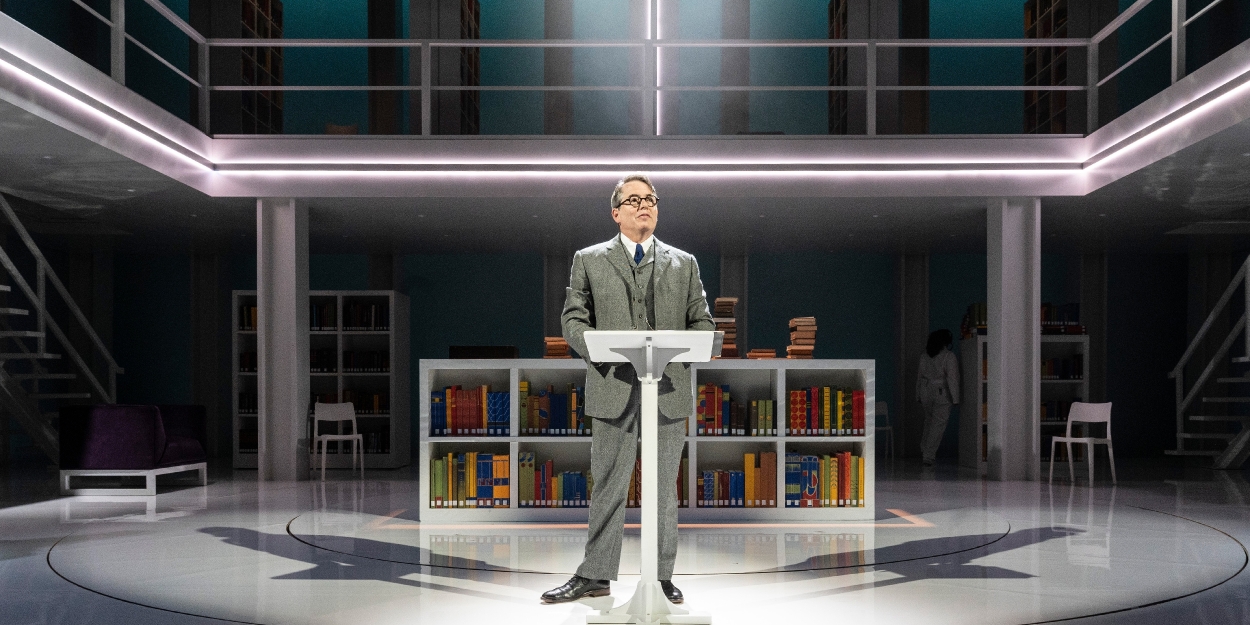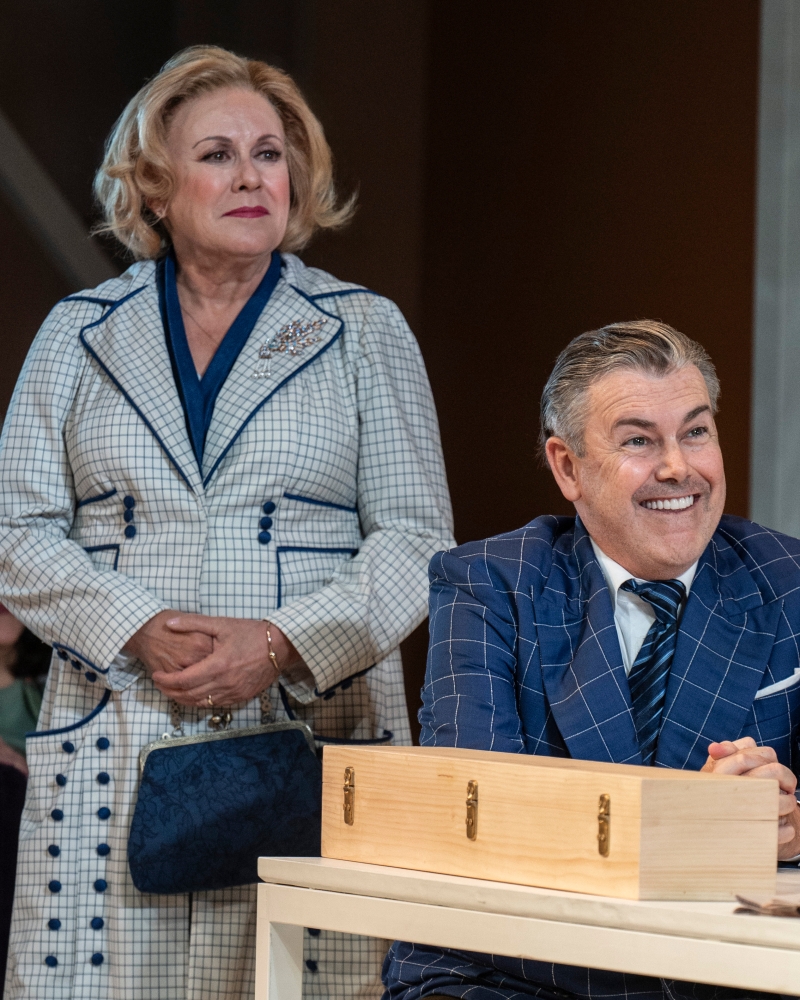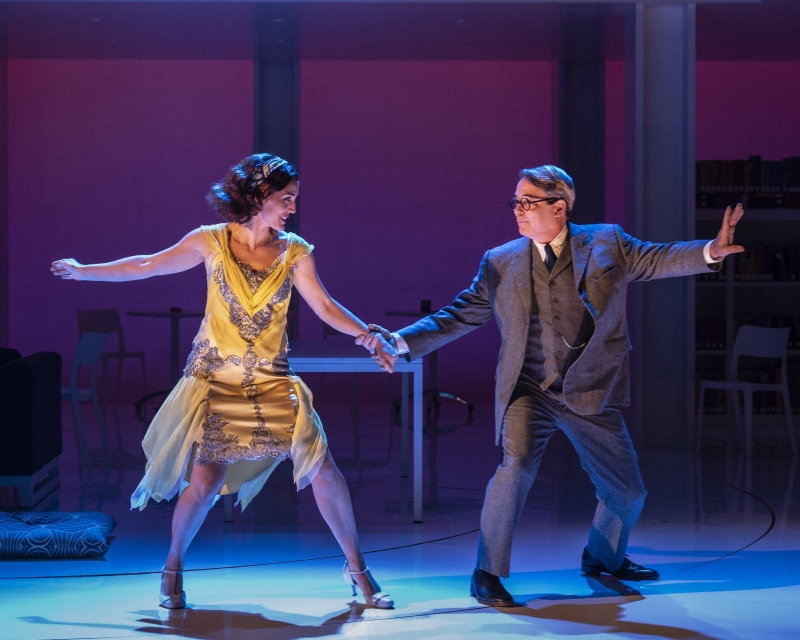Review: BABBITT at Shakespeare Theatre Company
Matthew Broderick stars in the Babbitt of BABBITTs.

The thing about Babbitt—the title character of Sinclair Lewis’ 1922 novel—is that everyone knows one — or even many. George F. Babbitt is something of an everyman: he’s a middle class, middle-aged man in Middle America who makes nothing.

But beneath the surface of his extraordinary ordinariness bubble imperfections and contradictions. Babbitt obsesses over every new-fangled gizmo and gadget but pushes back against any societal change, he believes the common working man should be well paid but is stringently against unions and labor movements, he flip flops between opposing political views at his own convenience, and rarely ever actually practices what he so loudly preaches.
Under Lewis’ relentless, highly critical lens, Babbitt’s brash businessman bravado is revealed to be powered by insecurities, inadequacies, and fear. Most prominently: fear of not properly fitting in. Drawing parallels between the growing standardization of American cities and the vilification of foreign immigrants, Lewis paints a portrait of an America in which conformity has taken over as the national religion and explores all the many ways in which that conformity works to hold back communal progress as well as individual self-realization.

Now, just over a century after its original publication, Babbitt is being put back center stage with a theatrical adaptation written by Joe DiPietro, directed by Christopher Ashley, and starring Matthew Broderick in the lead role.
At first glance, the pitch is obvious: Babbitt’s story of a bumbling, power-hungry, conservative businessman who stumbles into politicking for his own personal gain is something of a timelessly prescient fable that continues to feel more topical the longer it ages.
However, Babbitt’s not particularly easy to adapt. As a book it’s somewhat plotless, spending chapter after chapter mired in the mundane minutia of Babbitt’s life and the everyday goings-on of the fictional city/state of Zenith, Winnemac in the U.S. of A.
DiPietro rather forcefully corrals the sprawling novel into stage-worthy shape. In this much more structured and clearly arced telling, George F. Babbitt, “mid" in every sense of the word, suddenly realizes that while he has superficially achieved the American Dream—he has a well-paying job, a wife (Ann Harada), a family, a house, a car—he has done so at the cost of his own personal dreams. He lacks respect at work, in the community, and even at home, where he unsuccessfully attempts to convince his son (Chris Myers) to pursue a college degree and become a lawyer — what Babbitt wishes he had become. Finding himself utterly dissatisfied with his lot in life, he begins making small, uncharacteristic rebellions—such as using the guest towel to dry his hands—as well as writing and performing political speeches against the local labor movement.

While Babbitt’s speeches are comically rambling and ignorant, they resonate with the community of Zenith, and he quickly finds himself becoming the thing he’s always wanted to be: a very important person.
Success is fleeting though, as stepping out of the comfort zone of conformity has seemingly upended the delicate balance of his universe. With his wife just about ready to divorce him and his best friend (Nehal Joshi) unexpectedly in prison for attempted murder, Babbitt only doubles down on his growing acts of rebellion, engaging in an extramarital affair with a flapper (Mara Davi), cavorting with Bohemians, and switching over to the socialist cause.
It’s only when his wife suddenly requires immediate, life-saving surgery for acute appendicitis that Babbitt is finally brought back down to earth. Seeing that his non-conformity hasn’t brought about any real change other than to threaten his relationships with family and friends, he quietly slips back into the safety net of conservatism. In one last rebellious act, Babbitt attempts to give his son a chance at a more meaningful life by supporting him in his surprise marriage and plan to become a full-time mechanic.
Throughout this iteration there is an inescapable sense that Babbitt has been sanitized, sanded down. This starts with Babbitt himself. No one’s going to deny Matthew Broderick’s star presence, and he’s tremendously funny in this. But Broderick’s Babbitt is more Broderick than Babbitt, to be honest. There is little of Lewis’ gruff, grumpy, mean-spirited character in this softer, sillier, even lovably buffoonish portrayal.

It’s evident in the next most distinctive element of Babbitt as well: Lewis’ third-person narration. DiPietro attempts to keep this quality of the novel, distributing the narration amongst the seven non-Broderick cast members, credited as “storytellers” that jump between expositing, commenting, and playing many different roles.

The cast embodies their varied roles well. Matt McGrath is a standout; he brings his all to every different character, becoming entirely unrecognizable in the process. Another is Judy Kaye, who transforms on an absolute dime, and is boisterously charismatic throughout. Ali Stroker effortlessly leaps across decades, alternately playing the show’s youngest and oldest characters, while Mara Davi more literally leaps in a role that includes both an imaginary fairy and a dance instructor.

It’s unfortunate then that DiPietro’s take on Lewis’ wordy, droll prose doesn’t ever click properly. Somewhere in the transition from the page to the mouths of these seven storytellers it becomes awkward, with the actors stumbling over both their own lines and each others’ quite a bit more than would be expected from a cast of this caliber. Under Ashley’s direction the jokes are played big and for laughs, losing a lot of the understated nature of Lewis’ humor.
Then there’s the somewhat baffling decision to set the entire play in a pristinely white public library, hinting at a sort of framing device in which the storytellers are reading the book out to us. Leon Rothenberg’s two floor, rotating set does a perfectly good job of working both as a realistic library and also dynamically breaking out into multitudes of configurations that function as the many different settings of the show — all of which are notably not libraries, bar one very brief scene.

There’s a clear gesture towards a concept that constantly threatens to land more definitively then it ever actually does. The play is based on a book, superficially touches on books as symbols of empowerment and countercultural movements, and the contemporary issues of public libraries and book banning are occasionally reflected in the narrative. Still, there never develops the overarching motif that the giant, elaborate set suggests there ought to be, leaving the primary visual concept of the production like a simile missing a second half.
If anything, the almost clinical-looking, somewhat European set divorces Babbitt from its original setting of 1920s Zenith that Lewis so painstakingly crafted — to the degree that his journals included maps of the fictional town and detailed drawings of the Babbitt house interior.
Instead, this Babbitt gets a bit lost in some ambiguous middle ground. It’s definitely no period piece, but neither is it really updated to feel current for the 2020s. The dialogue is too modernized to feel true to its original author’s intentions, and not modernized enough to feel as relevant for today as the book was in 1922.
Ultimately, what’s gone is that sense of sharpness. The original’s precise, cutting satire has been swapped with broad parody, distantly removed from Lewis’ unapologetically grounded critique of 1920s America and its racism, misogyny, and violence against oppressed minorities. Whereas the book pinpointedly put its finger on the pulse of a rapidly changing American society, the play vacuously gestures towards nothing in particular.
Upon release, Babbitt was praised as stunningly real by supporters and slammed unkind and nasty by critics — a hundred years on DiPietro’s version is far too comfortable preaching mainstream liberal dogma to the long-converted theater choir.
In a sense, it’s become the Babbitt of Babbitts.

Babbitt runs through November 3rd at Shakespeare Theatre Company's Harman Hall. Performances are around two hours with one fifteen-minute intermission.
Reader Reviews

Videos

